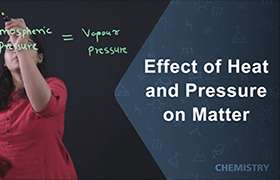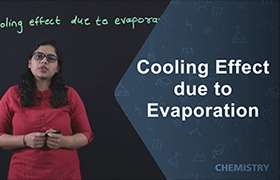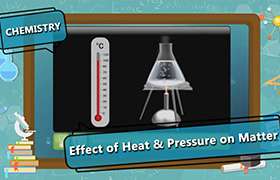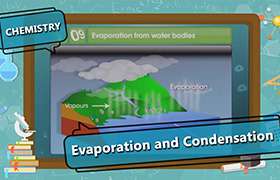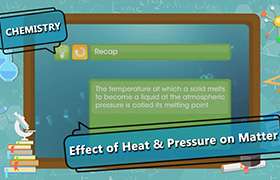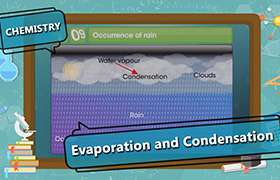CBSE Class 9 Answered
In chemistry, a solution is a homogeneous mixture composed of two or more substances. In such a mixture, a solute is dissolved in another substance, known as a solvent. A common example is a solid, such as salt or sugar, dissolved in water, a liquid. Gases may dissolve in liquids, for example, carbon dioxide or oxygen in water. Liquids may dissolve in other liquids. Gases can combine with other gases to form mixtures, rather than solutions.[1] All solutions are characterized by interactions between the solvent phase and solute molecules or ions that result in a net decrease in free energy. Under such a definition, gases typically cannot function as solvents, since in the gas phase interactions between molecules are minimal due to the large distances between the molecules. This lack of interaction is the reason gases can expand freely and the presence of these interactions is the reason liquids do not expand.
Examples of solid solutions are alloys, certain minerals and polymers containing plasticizers. The ability of one compound to dissolve in another compound is called solubility. The physical properties of compounds such as melting point and boiling point change when other compounds are added. Together they are called colligative properties. There are several ways to quantify the amount of one compound dissolved in the other compounds collectively called concentration. Examples include molarity, molality, and parts per million (ppm).
In chemistry, a solution is a homogeneous mixture composed of two or more substances. In such a mixture, a solute is dissolved in another substance, known as a solvent. A common example is a solid, such as salt or sugar, dissolved in water, a liquid. Gases may dissolve in liquids, for example, carbon dioxide or oxygen in water. Liquids may dissolve in other liquids. Gases can combine with other gases to form mixtures, rather than solutions. All solutions are characterized by interactions between the solvent phase and solute molecules or ions that result in a net decrease in free energy. Under such a definition, gases typically cannot function as solvents, since in the gas phase interactions between molecules are minimal due to the large distances between the molecules. This lack of interaction is the reason gases can expand freely and the presence of these interactions is the reason liquids do not expand.
In chemistry, a suspension is a heterogenous fluid containing solid particles that are sufficiently large for sedimentation. Usually they must be larger than 1 micrometreThe internal phase (solid) is dispersed throughout the external phase (fluid) through mechanical agitation, with the use of certain excipients or suspending agents. Unlike colloids, suspensions will eventually settle. An example of a suspension would be sand in water. The suspended particles are visible under a microscope and will settle over time if left undisturbed. This distinguishes a suspension from a colloid in which the suspended particles are smaller and do not settle. In a solution, the dissolved substance does not exist as a solid and the two are homogeneously mixed.
A suspension of liquid droplets or fine solid particles in a gas is called an aerosol. In the atmosphere these consist of fine dust and soot particles, sea salt, biogenic and volcanogenic sulfates, nitrates, and cloud droplets.
Suspensions are classified on the basis of the dispersed phase and the dispersion medium, where the former is essentially solid while the latter may either be a solid, a liquid or a gas.
Examples of solid solutions are alloys, certain minerals and polymers containing plasticizers. The ability of one compound to dissolve in another compound is called solubility. The physical properties of compounds such as melting point and boiling point change when other compounds are added. Together they are called colligative properties. There are several ways to quantify the amount of one compound dissolved in the other compounds collectively called concentration. Examples include molarity, molality, and parts per million (ppm).vvvvvvvvvvA colloid is a type of mechanical mixture where one substance is dispersed evenly throughout another. Because of this dispersal, some colloids have the appearance of solutions. A colloidal system consists of two separate phases: a dispersed phase (or internal phase) and a continuous phase (or dispersion medium). A colloidal system may be solid, liquid, or gaseous.
The dispersed-phase particles have a diameter of between approximately 5 and 200 nanometers. Such particles are normally invisible to an optical microscope, though their presence can be confirmed with the use of an ultramicroscope or an electron microscope. Homogeneous mixtures with a dispersed phase in this size range may be called colloidal aerosols, colloidal emulsions, colloidal foams, colloidal dispersions, or hydrosols. The dispersed-phase particles or droplets are largely affected by the surface chemistry present in the colloid.
Some colloids are translucent because of the Tyndall effect, which is the scattering of light by particles in the colloid. Other colloids may be opaque or have a slight color.

